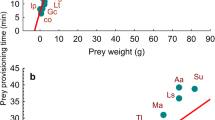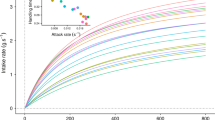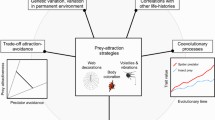Summary
We distinguish three cases which consider the effect of information on animal behaviour: static information, obligate information and facultative information. Static information deals with the case in which the animal does not acquire additional information; it starts with enough information to discriminate options. Obligate information deals with the case in which the animal acquires information at no additional cost. Facultative information is when the animal may choose to pay a cost in order to acquire information. We illustrate the differences among these three situations by analysing the optimal diet problem subject to the different information regimes. Compared to the case with static information, obligate recognition time narrows the range of prey densities over which an optimal forager feeds selectively, and facultative recognition time reduces it further still. The three models yield qualitatively different predictions regarding how the optimal diet varies with relative abundances of alternative resources. In the space of resource densities, the line separating the optimal behaviours of selectivity and opportunism is straight for both the perfect and obligate information cases. In the case of facultative recognition time this line or isoleg is part of a quadratic curve. This non-linearity yields two completely new predictions: a less profitable resource may be lost from the diet after becoming more abundant and the poor resource may be included in the diet as a result of the rich resource becoming more common.
Similar content being viewed by others
References
Abrams, P. (1987) The functional responses of adaptive consumers of two resources.Theor. Pop. Biol. 33, 262–88.
Alcock, J. (1989)Animal Behavior (4th edn.) Sinauer Associates, Sunderland, MA.
Bakker, K., Bagchee, S.N., Zwet, W.R. and van Meelis, E. (1967) Host discrimination inPseudiocoila Bachni (Hymenoptera: Cynipidae).Entomol. Exp. Appl. 10, 295–311.
Bakker, K., Eijsackers, H.J.P., van Lenteren, J.C. and Meelis, E. (1972) Some models describing the distribution of eggs in the parasitePseudeucoila bochci (Hym: Cynip.) over its hosts, larvae ofDrosophila melanogaster Oecologia 10, 29–57.
Brower, L.P. and Glazier, S.C. (1975) Localization of heart poisons in the Monarch butterfly.Science 188, 19–25.
Brown, J.S. and Mitchell, W.A. (1989) Diet selection on depletable resources.Oikos 54, 33–43.
Elner, R.W. and Hughes, R.N. (1978) Energy maximization in the diet of the shore crab,Carcinus maenus.J. Anim. Ecol. 47, 103–16.
Gilbert, L.E. (1983) Coevolution and mimicry. InCoevolution (D. J. Futumya and M. Slatkin, eds), pp. 263–81, Sinauer Associates, Sunderland, MA.
Gill, F.B. (1990)Ornithology. W.H. Freeman, New York.
Hollings, C.S. (1959) Some characteristics of simple types of predation and parasitism.Can. Entomol. 91, 385–98.
Holt, R.D. (1983) Optimal foraging and the form of the predator isocline.Am. Nat. 122, 521–41.
Holt, R.D. and Kotler, B.P. (1987) Short-term apparent competition.Am. Nat.,130, 412–30.
Houston, A.I., Krebs, J.R. and Erichsen, J.T. (1980) Optimal prey choice and discrimination time in the great tit (Parus major).Behav. Ecol. Sociobiol. 6, 169–75.
Hughes, R.N. (1979) Optimal diets under the energy maximization premise: the effects of recognition time and learning.Am. Nat. 113, 209–21.
Huntingford, F. (1984).The Study of Animal Behaviour. Chapman & Hall, New York.
Iwasa, I., Higashi, M. and Yamamura, N. (1981) Prey distribution as a factor determining the choice of optimal foraging strategy.Am. Nat. 117, 710–23.
Krebs, J.R. and Inman, A.J. (1992) Learning and foraging: individuals, groups and populations.Am. Nat. 140, S63–84.
Lessells, C.M. (1985) Parasitoid foraging: should parasitism be density dependent?J. Anim. Ecol. 54, 27–41.
McNamara, J. (1982) Optimal patch use in a stochastic environment.Theor. Pop. Biol. 21, 269–88.
Mangel, M. and Clark, C.W. (1988)Dynamic Models in Behavioral Ecology. Princeton University Press, Princeton, NJ.
Murdock, W.W. (1969) Switching in general predators: experiments on predator specificity and stability of prey populations.Ecol. Monogr. 39 335–54.
Papaj, D.R and Vet, L.E.M (1990) Odor learning and foraging success in the parasitoid,Leptopilina heterotoma.J. Chem. Ecol. 16, 313–50.
Pulliam, H.R. (1974) On the theory of optimal diets.Am. Nat. 108, 59–75.
Rosenzweig, M.L. (1981) A theory of habitat selection.Ecology 62, 327–35.
Salt G,. (1961) Competition among insect parasitoids.Symp. Soc. Exp. Biol. 15, 96–119.
Sih, A. (1979) Optimal diet: the relative importance of the parameters.Am. Nat. 113, 460–3.
Stephens, D.W. (1989) Variance and the value of information.Am. Nat. 134, 128–40.
Stephens, D.W. and Krebs, J.R. (1986)Foraging theory. Princeton University Press, Princeton, NJ.
Thomas, G.B. Jr (1972)Calculus and Analytic Geometry. Addison-Wesley, Reading, MA.
Valone, T.J (1990)Information and exploitation: patch assessment strategies in birds and mammals. Ph D Dissertation, University of Arizona, Tucson.
Valone. T.J. and Brown, J.S. (1989) Measuring patch assessment abilities in desert granivores.Ecology 70, 1800–10.
van Lenteren, J.C. (1976) The development of host discrimination and the prevention of superparasitism in the parasitePseudocoila bochei (Hym: Cynipidae).Neth. J. Zool. 126, 1–83.
van Lenteren, J.C. and Bakker, K. (1978) Behavioural aspects of the functional response of a parasite (Pseudocoila bochei Weld) to its host (Drosophila melanogaster).Neth, J. Zool,28, 213–33.
Vinson, S. B. (1976) Host selection by insect parasitoids.Ann. Rev. Entomol.,21, 109–33.
Author information
Authors and Affiliations
Rights and permissions
About this article
Cite this article
Kotler, B.P., Mitchell, W.A. The effect of costly information in diet choice. Evol Ecol 9, 18–29 (1995). https://doi.org/10.1007/BF01237693
Issue Date:
DOI: https://doi.org/10.1007/BF01237693




